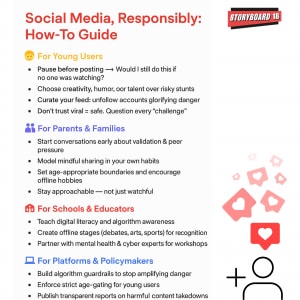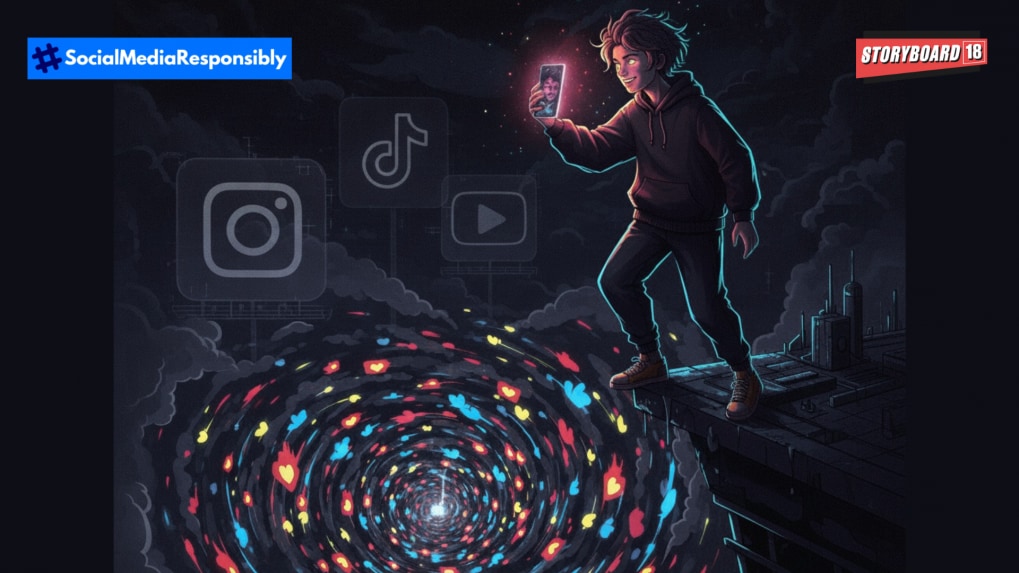#SocialMediaResponsibly: The new peer pressure - Why "How many views?" is replacing "How are you?"
What emerges across expert perspectives is not a call for censorship, but a call for responsibility and balance on social media.
ADVERTISEMENT
Note to readers:
In an always-on world, the way we use social media shapes not just our lives but the safety and wellbeing of those around us. 'Social Media, Responsibly' is our commitment to raising awareness about the risks of online recklessness, from dangerous viral trends to the unseen mental and behavioural impacts on young people. Through stories, conversations and expert insights, we aim to empower individuals to think before they post, to pause before they share, and to remember that no moment of online validation is worth risking safety. But the responsibility does not lie with individuals alone. Social media platforms must also be accountable for the environments they create, ensuring their tools and algorithms prioritise user safety over virality and profit. It’s time to build a culture where being social means being responsible - together.
“When I was hired for this role eight years ago, the Board of Directors was very concerned about an online phenomenon called blue whale,” recalls Dr. Ted Mockrish, Head of School, Canadian International School, Bangalore. “If you remember, blue whale led teens down a rabbit hole that ultimately ended in their being asked to commit suicide; many did. The destructive influence of social media is absolutely real and companies absolutely bear responsibility for what is on their platforms.”
Dr. Mockrish’s words are a reminder that this is not an abstract debate. The rise of viral challenges, dangerous stunts, and reels culture among school students in India is not just a matter of taste or trend. It is a matter of life, death, and the psychology of impressionable young people navigating the digital age.
A billion dollar industry exploiting risk
Mockrish points out that social media companies know exactly how their products land on developing brains. “Worldwide, we are fighting a multi billion dollar industry that is exploiting the natural risk taking behaviors of teens for their own gain,” he says. The neurological vulnerability is real. Between the ages of 10 and 25, brains are wired differently, with underdeveloped prefrontal cortices making long term judgment weaker and peer approval stronger.
“As children move from childhood into adulthood, their primary focus shifts from family to friends,” Mockrish explains. “In group status sought with peers may be seen as overt or irrational risk taking, but is actually quite a predictable pattern of acceptance seeking.”
This is why simple bans do not work. “Banning social media is not the answer,” he insists. “Open dialogue with students over the long term is the only way to support teen understanding of the very powerful corrupting qualities of social media. Just saying no is as ridiculous a strategy as 100 percent permission to use social media.”
Stunts in the corridors, not just on screens
If social media challenges once seemed distant, they are now very much part of everyday school life. Kanak Gupta, Group Director, Seth M.R. Jaipuria Schools, says: “Yes, and that is the worrying part. Students are not just consuming this content, they are talking about it in corridors and WhatsApp groups. Even if they do not try it themselves, the conversation normalizes it. The danger is not just in doing the stunt, but in feeding the culture where risk is rewarded with views.”
For adolescents, the line between entertainment and endangerment is thin. Gupta stresses that likes often feel more real than risks. “Most of them know the risks. They are not naïve. But knowledge is not the same as wisdom. Adolescents are neurologically wired to seek risk, novelty, and peer validation. They may know the risks intellectually, but in the rush of adrenaline and social approval, the dopamine hit of validation feels stronger than the fear of falling.”
This is why, according to him, information campaigns alone will never be enough. “What we need are empathy driven conversations where students process consequences emotionally, not just rationally. At our schools, we talk about these issues openly and constantly. A culture needs to be built around values.”
The new report card: “How many views?”
Peer pressure has always existed, but the metrics have changed. Gupta notes, “The definition of cool has shifted. Earlier, it was about fashion or grades. Today, it is about visibility. ‘How many views?’ has quietly replaced ‘How are you doing?’ Peer pressure used to be about fashion, grades, or friend circles. Now it is about digital visibility. The irony is that students think they are being ‘different,’ but most are just copying the same viral template.”

Kshitija Sawant, University Psychologist Counsellor, Somaiya Vidyavihar University, Mumbai, observes similar dynamics: “There is an increase in peer pressure to make reels on what is the latest trending thing. Those who fit the bill often garner attention and become popular. They might even be looked up to by their peers regardless of the actual risks involved.”
The psychology of invincibility
For Sawant, part of the issue is not just lack of awareness, but misplaced belief in invulnerability. “Many students tend to underestimate the dangers involved in performing risky activities and some believe that they are immune to threats. There is a gap in awareness as many truly believe that what they read about in newspapers or watch on TV news can never actually happen to them.”
Underlying this, she says, are deeper struggles: “Some hail from dysfunctional family backgrounds or have a poor judgment of what is right and what is wrong. Many tend to be low on self confidence and might also be dealing with self esteem related issues. Engaging in risky activities becomes a way of seeking validation even if it turns out to be fatal.”
Platforms, culpable or passive observers?
When asked whether platforms should take stronger action, the consensus is clear. “Yes, and not in a token way,” Gupta says. “Platforms already run on algorithms that can predict what we will click next. If they can monetize attention, they can also moderate danger. With great reach comes great responsibility.”
Sawant suggests very practical interventions: longer and clearer disclaimers, algorithms that push content from professional stunt performers rather than glamorizing amateur risk, and filters that prevent dangerous templates from going viral.
A common refrain among educators is that schools cannot act in isolation. Gupta says, “At Seth M.R. Jaipuria Schools, we have built avenues like the Reflection Chronicle and digital portfolios, where students can showcase originality and express themselves authentically. When children feel seen for who they are, they do not need to chase visibility through reckless stunts.”
He adds a personal note: “As a parent, I make this effort every day with my teenage daughter, patiently discussing with her the struggle worth choosing is not dangling from a cliff for ten seconds of fame, but daring to be authentic in a world that rewards imitation.”
Mockrish insists parent education is just as crucial. “Parents secretly thank us for banning cell phones on campus and social media, but may not follow through at home for fear of causing a fight. This is a 360 degree effort. We want and welcome parents as partners to understand that our knowledge is not the problem; translating it into wisdom is.”
Toward responsibility, not censorship
What emerges across these perspectives is not a call for censorship, but for responsibility and balance. Sawant frames it through “E2C” — Education, Employment, and Critical Thinking Skills — as the new normal. Agarwal emphasizes values of self awareness and resilience. Gupta highlights empathy driven conversations and creative outlets. And Mockrish pushes for political backbone to counterbalance the billion dollar lobbying power of platforms.
The red thread is clear: creativity must never come at the cost of safety. As Gupta sums it up: “Creativity is not about risking your life, it is about risking your imagination. If schools and parents provide platforms where every child’s voice is amplified in meaningful ways, the temptation to chase reckless trends automatically reduces.”
And as Mockrish’s opening reminder makes plain, ignoring the stakes is not an option. Social media is not just shaping attention, it is shaping survival.
What You Can Do: Practical Steps for Safer Social Media
For Young Users
Pause before posting: Ask yourself—would I still do this if nobody was watching?
Choose safer ways to stand out: Showcase creativity, humor, or talent instead of risky stunts.
Curate your feed: Follow accounts that inspire, educate, or entertain positively. Unfollow or mute pages that glorify dangerous trends.
Check the source: If a challenge looks risky, it probably is. Don’t trust trends just because they’re viral.
For Parents and Families
Open conversations early: Talk about self-worth, validation, and peer pressure before children start using social media.
Model digital responsibility: Kids copy what they see—show them mindful sharing in your own habits.
Set healthy boundaries: Delay access to platforms where possible, and encourage offline hobbies that build confidence.
Be approachable, not just watchful: Teens are more likely to share concerns if they don’t fear punishment.
For Schools and Educators
Integrate digital literacy: Teach students how algorithms work and how online behavior shapes mental health.
Create alternative stages: Give students offline platforms—debates, art exhibitions, performances—where they can shine.
Collaborate with experts: Invite mental health professionals and cyber psychologists for awareness workshops.
For Platforms and Policymakers
Algorithmic guardrails: Stop amplifying content that glorifies danger.
Age-gating enforcement: Ensure stronger checks on underage users.
Transparent reporting: Regularly disclose how much harmful content is removed and how algorithms are being adjusted.
Support cultural shifts: Highlight and reward safe, creative challenges to reset what “going viral” looks like.
Social media doesn’t have to be a stage for reckless validation. By combining personal responsibility, family guidance, institutional education and platform accountability, we can build a culture where being seen online doesn’t come at the cost of being safe offline.
Read More:#Social Media Responsibly: When online fame turns risky: platforms face growing scrutiny
Read More:#SocialMediaResponsibly: Risky selfies, reckless stunts in dangerous pursuit of online validation


